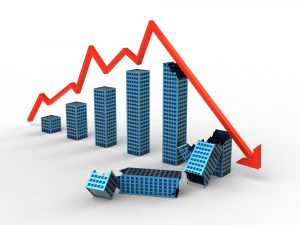
By Richard Morey
January 3, 2024
 Inflection Point in US Economy?
Inflection Point in US Economy?
There are many indications our economy is at an inflection point. According to the Bureau of Economic Analysis, spending rose .1% in October and.2% in November. Those are positive numbers. On the flip side, we saw an explosion of “Buy Now Pay Later” purchases this holiday season – the weakest and most desperate way to continue to spend beyond one’s means.
The labor market presents a similar picture. The Bureau of Labor Statistics continues to put out positive monthly employment numbers, but a closer look at the data shows a continuing, accelerating loss of full-time jobs. In the last half of 2022 we lost 500,000 full-time jobs, and over 1.5 million last year. Most new jobs created are part-time, taken by multiple job-holders. In total, the number of hours worked decreased last year. If the employment market is so good, why are all the workers combined working fewer hours?
At the same time, we’re not hearing about too many mass layoffs, and the average person looking for a job can likely still find one. This is what you’d expect to see during an inflection point in which the economy shifts overall direction.
Another area where you can see wide discrepancies are the economic survey numbers on manufacturing versus the service sectors. The last I looked, manufacturing was in a 13-month slump in which it has been in recession every single month. At the same time, the larger services sector showed strong growth in the second half of 2023 – almost entirely due to growth in the public sector, i.e. jobs connected to government spending.
The big question then becomes which direction it will move from here? In my opinion, inflation has likely tipped the balance, and we are headed into negative territory. Last year we saw a final, “last-gasp” of debt-fueled growth. This was all due to increased government hiring/spending, but it’s safe to say the House Republicans will stop any more extra money from going out the door in 2024. This alone is enough to tip the economy from growth to severe contraction this year.
Will the Chinese Real Estate Crisis Negatively Affect the US Economy?
As most readers know, perhaps my greatest area of study has involved debt bubbles, their history and effects on markets. In the U.S., we now have the largest such bubble in our nation’s history, encompassing our corporate sector, households, and federal government. Unlike others in history, similar debt bubbles have also been inflated around the world. One is already popping – with disastrous consequences – in faraway China.
I don’t have any idea what impact a dropping Chinese economy will have on the United States’ economy, but it seems naïve to think it won’t be a problem for us. China remains a huge trading partner and – until heretofore, a big contributor to overall world GDP.
In the back of my mind I always remember recent history – 2019-2010 – when debt-fueled economic growth from China was attributed to bringing back the world from the mortgage crisis. They were nearly the sole engine that pulled the economy up after that crisis. It was, of course, all debt-financed. That approach always comes back to roost – especially when your nation’s investors begin to believe price doesn’t matter, in their case because both “the government will protect me from loss” and “real estate prices always go up.”
 Now apartment prices are down 25% in Beijing, the strongest real estate market in the country, and 35% or more in other parts of the country. Chinese real estate developers – the largest in the world – are going bankrupt one by one. Local governments and banks are also teetering on the edge.
Now apartment prices are down 25% in Beijing, the strongest real estate market in the country, and 35% or more in other parts of the country. Chinese real estate developers – the largest in the world – are going bankrupt one by one. Local governments and banks are also teetering on the edge.
Moreover, 70% of the net worth of the Chinese public is invested in real estate. Add in the fact this real estate is highly leveraged, and you get a recipe for disaster – defined as wholesale defaults on mortgages with the public losing most of their previous “wealth,” and all but central-government owned banks and companies being at risk of bankruptcy (but you can’t discharge household debt through bankruptcy in China; instead, those who default on mortgages are essentially being cast out of Chinese society).
Of course, this real estate downturn has led to a contraction in the entire employment picture, with educated, young Chinese people unable to find jobs. The young Chinese economists working for The Financial Times I study now describe the economic contraction going on in China as a full-fledged financial crisis. They also say nobody can see a bottom to these losses – something echoed by President Xi recently himself.
More Economic Questions than Answers?
My economic questions for 2024 include:
- How will the bursting of China’s debt bubble affect Europe & the US?
- Will other unsettling geopolitical events occur which will affect our debt bubble and therefore economy and stock market?
- Alternatively, will our asset bubbles deflate due solely to high prices meeting a recession – whether mild or more severe?
- Or will this bubble era come to an end due to something that is completely unforeseen?
Why I’m Concerned About a Coming Inflation-Caused Recession
The last economic topic to cover as we look ahead involves past, present and future inflation concerns. I maintain past inflation has done economic damage we don’t yet fully see. The price of money impacts everything and everyone in an economy. When the growth spurt side of the inflationary economic event is finally doused, you’ve got damage everywhere to your consumers and companies.
This damage should start to come more into view when companies can’t refinance their many trillions in corporate and commercial real estate loans this year.
Fortunately, inflation appears to have receded fairly dramatically in the last year. A contracting China nearly guarantees inflation pressures will continue to fall – unless something happens in a war which shuts off oil supplies or other key materials, or something else unpredictable occurs on the world stage.
Regarding our bout with inflation and a potential coming recession, here are some sobering facts:
- Raising interest rates (let alone over 5%!) has a near-perfect record of leading to recessions.
- The last interest rate hike was in July. It typically takes 9-18 months after the last rate increase before we land in recession. This means the earliest we would expect inflation/rate hikes to push us into recession is March of this year.
- An even more accurate red flag is the pronounced inverted yield curve, which we have had since October of 2022. Whenever long interest rates are lower than short rates, a recession ensues (there are a few exceptions, but only when the curve wasn’t nearly as inverted as today). The average lag time (with a wide range of 9 months to over 2 years) for this is 18 months. If we have the average lag time between yield curve inversion and recession, that would put us at April of this year.
Conclusion
As described, multiple flashpoints in domestic and international economies could set off complex, potentially disastrous chain reactions across the globe. The message for investors is that now, more than ever, is the time to position investment portfolios defensively. At the same time, as soon as we see the risks actually striking markets, we will undoubtedly have opportunities to profit from that fact.
We plan to keep our portfolios safe until either all these unusually large risks dissipate, or one or more of them go off and pull the prices of risk assets – which are more overpriced than any time in history except three weeks in the fall of 1929 – back down to earth.
Our somewhat unique approach to extraordinary risk is designed to safely make extra money on the way down and then make even more for numerous years thereafter. This is essentially called “Selling high and buying low.” This is what you do when you establish a negative correlation to stocks at their high and then buy after they’ve gone down.
In this case, we’re carefully following very large macroeconomic events, and letting those facts, and the risks they reveal, lead our investment decisions. This is especially true today. If the risk of a more severe economic downturn than presently expected leads to greater than currently imagined market risk, we’re fully ready.
